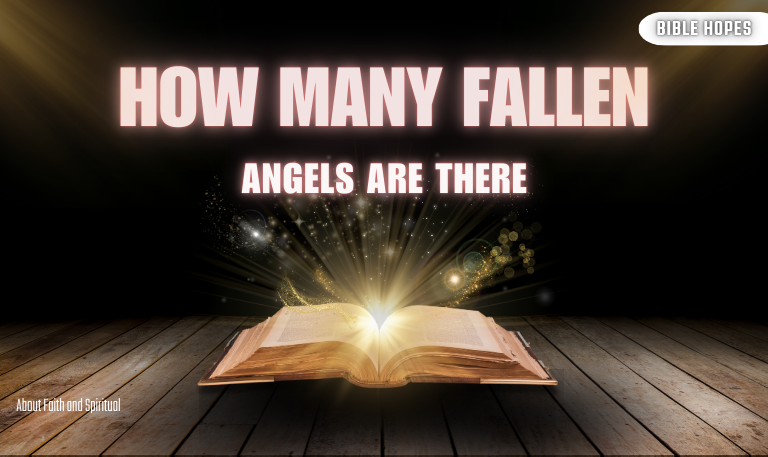The concept of fallen angels has intrigued scholars, theologians, and curious minds for centuries. Often depicted as celestial beings who rebelled and were cast out of heaven, fallen angels are central to many religious and mythological narratives. But one of the most frequently asked questions is: How many fallen angels are there?
This question, while seemingly straightforward, leads us into a complex labyrinth of ancient texts, religious traditions, and theological debates. In this comprehensive guide, we’ll explore biblical accounts, apocryphal writings like the Book of Enoch, religious interpretations, and cultural influences to uncover what the texts say — and what they don’t.
Understanding Fallen Angels: Definitions and Context
Before diving into numbers, it’s crucial to understand who fallen angels are and how they differ from other supernatural entities.
Fallen angels are typically described as angels who disobeyed God and were expelled from heaven.
They are often conflated with demons, but these terms are not always synonymous.
Their stories appear in Christianity, Judaism, and Islam, with variations in names and roles.
Read Also: Bible Verses About Becoming A New Person
Fallen Angels in the Bible: What Does Scripture Say?
Old Testament References
The Old Testament doesn’t explicitly use the term “fallen angels,” but passages like Isaiah 14:12-15 and Ezekiel 28:12-19 have been interpreted as referring to rebellious heavenly beings.
The concept of angelic rebellion is implicit, but specific numbers aren’t detailed.
New Testament Insights
The New Testament offers some hints, especially in Revelation 12:4, where it describes a dragon sweeping a third of the stars from the sky, commonly interpreted as one-third of the angels falling.
The apostle Peter (2 Peter 2:4) mentions angels who sinned and were cast into hell, but again, no explicit number is given.
The Book of Enoch: The Most Detailed Account
The Book of Enoch, a Jewish apocryphal text dating from the Second Temple period, offers the most detailed narrative about fallen angels.
The Watchers and Their Descent
The Book of Enoch introduces the Watchers—a group of 200 angels who descended to Earth.
These angels, led by chiefs like Samyaza and Azazel, corrupted humanity by teaching forbidden knowledge and engaging with human women.
The Number 200: A Key Figure
According to Enoch 6:1-7, exactly 200 angels rebelled, suggesting this as the canonical number of fallen angels in this tradition.
The text provides names for 20 leaders, with the remainder considered followers.
The “One-Third” Fallen Angels: Symbolism and Interpretation
The phrase “one-third of the angels fell” comes primarily from Revelation 12:4. Scholars debate its meaning:
Literal interpretation: Suggests that exactly one-third of all angels fell, a significant but undefined number.
Symbolic interpretation: One-third may represent a large but indefinite portion, emphasizing the scale of the rebellion rather than an exact figure.
Religious Traditions on the Number of Fallen Angels
Christianity
Most Christian traditions reference the symbolic “one-third” from Revelation but do not define a precise number.
The Catholic Church views fallen angels as real but does not officially specify their number.
Many Protestant interpretations vary widely.
Judaism
The Book of Enoch is not canonical in most Jewish traditions, but its influence is recognized.
Other Jewish texts mention fallen angels, but do not quantify them.
Islam
Islam differentiates between angels (always obedient) and jinn (free-willed beings who can sin).
Fallen angels as described in Christian texts do not have a direct equivalent; thus, the question of number does not apply similarly.
Names and Roles of Notable Fallen Angels
A few fallen angels frequently mentioned across traditions include:
| Name | Role/Notoriety |
|---|---|
| Azazel | Taught humans warfare and cosmetics, associated with scapegoat rituals |
| Samyaza | Leader of the Watchers’ rebellion |
| Belial | Embodies wickedness and worthlessness |
| Lucifer | Often identified as the “morning star,” synonymous with Satan in Christian tradition |
Fallen Angels vs. Demons: What’s the Difference?
Fallen angels are originally angels who rebelled and fell.
Demons are often considered spirits of the dead or malevolent beings.
Over time, many fallen angels were equated with demons, but their origins differ.
Fallen Angels in Literature and Pop Culture
Modern portrayals often blur theological specifics:
Movies, TV shows, and books may depict hundreds or thousands of fallen angels.
Numbers vary wildly, reflecting creative license rather than scriptural accuracy.
Scholarly Perspectives: Why Is the Number Unclear?
Ancient texts use symbolic language, complicating exact counts.
Many scriptures focus on the meaning of the fall rather than numeric details.
Variations in translations and interpretations add to the uncertainty.
Summary Table: Numbers of Fallen Angels in Various Sources
| Source | Number of Fallen Angels |
|---|---|
| Bible (Revelation 12:4) | One-third of angels (undefined) |
| Book of Enoch | 200 |
| Christian Tradition | Symbolic, varies |
| Jewish Tradition | Not explicitly stated |
| Islamic Texts | Not applicable |
Why Does the Number of Fallen Angels Matter?
Understanding the number informs:
Theological views on evil and rebellion
The scope of spiritual warfare narratives
Cultural and literary symbolism
How Many Fallen Angels Are There FAQs
Q1: How many fallen angels are mentioned in the Bible?
The Bible does not give a specific number, but Revelation 12:4 implies one-third of the angels fell.
Q2: Is the number 200 of fallen angels confirmed?
The Book of Enoch mentions 200 fallen angels called Watchers, but this is an apocryphal text not accepted by all traditions.
Q3: Are fallen angels the same as demons?
Not exactly; fallen angels are angels who rebelled, whereas demons are often considered evil spirits but can have different origins.
Q4: What does “one-third of the angels fell” mean?
It is often seen symbolically, suggesting a large portion of angels rebelled, though interpretations vary.
Q5: Can we know the exact number of fallen angels?
No definitive number exists across all traditions due to symbolic language and varying texts.
Conclusion
The question “How many fallen angels are there?” invites more than a simple answer. While the Book of Enoch offers the figure of 200 rebellious angels, canonical biblical texts emphasize symbolic numbers like one-third of the angels. Religious traditions differ, and scholars acknowledge the difficulty in pinpointing an exact count. Ultimately, the number serves as a symbol of the vastness of rebellion and the spiritual battle rather than a fixed statistic. Understanding these nuances enriches our grasp of religious history, theology, and the human fascination with the cosmic struggle between good and evil.


![15 Pink Bible Verses | Discover Meaning, Love [2025 Guide] 4 15-Pink-Bible-Verses-Discover-Meaning,-Love-[2025-Guide]](https://biblehopes.com/wp-content/uploads/2025/05/15-Pink-Bible-Verses-Discover-Meaning-Love-2025-Guide.png)
